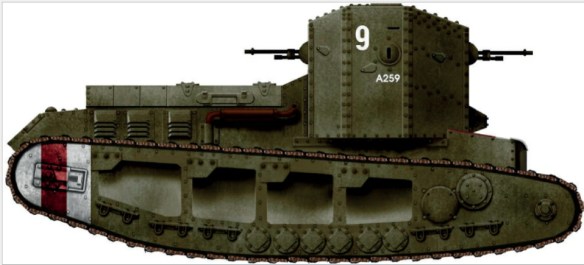A late production medium Mark ‘A’ Whippet, No. A259 ‘Caesar II’, now in The Tank Museum in Bovington.
Captured Beutepanzer medium Mark A Whippet. Large German Army Bundeswehr Schwarzes Kreuz black crosses were painted on the captured tanks to identify the fact that they were under new management.
The German Sturmpanzerwagen A7V’s quick-firing 57mm Maxim-Nordfeldt QF cannon could fire high-explosive and canister shot shells at soft-skinned vehicles, artillery field guns and troops. For armoured targets such as the Mark IV and Whippet tanks it could fire armour-piercing Panzerkampf shells. It was also armed with six machine guns.
Slightly later on the same morning, 24 April 1918, an RAF plane on a reconnaissance patrol spotted German troops moving towards the village of Cachy. He dropped a warning message to the British troops held in reserve behind the Cachy Switch trenches by the Bois l’Abbé woods north of the village of Cachy.
Two Sturmpanzerwagen A7V tanks of the 2nd Sturm-Panzerkraftwagen Abteilung (tank battalion) – ‘Siegfried’ II No. 525 commanded by Lt Friedrich-Wilhelm Bitter and ‘Schnuck’ No. 504 commanded by Lt Albert Müller – were driving towards the British trenches in front of the village of Cachy in support of the advancing infantry.
At around 12.20 p.m., seven British medium Mark A Whippets of ‘X’ Company, 3rd Battalion, 3rd Tank Brigade, armed only with 0.303 calibre Hotchkiss machine guns, moved towards the advancing German infantry, which they managed to halt and in some areas turn back.
The German infantry commander contacted Lt Bitter and directed him towards the Whippets; Lt Müller’s tank was too far south at that stage.
Caught out in the open flat farmland with a German heavily armed tank aiming its 57mm gun at them, the Whippet tank commanders soon realised the perilous situation they were in. They had no weapon that could knock out the enemy tank, so tried to escape. The German A7V tank’s quick-firing 57mm cannon could fire high-explosive and canister shot shells at soft-skinned vehicles, artillery field guns and troops. For armoured targets such as the Whippet tank it could fire armour-piercing Panzerkampf shells.
Lt Bitter’s gunner’s first shot missed 2Lt Harry Dale’s Whippet No. A256 but his second shot at a range of 200m set it on fire. The German gunner then fired at 2Lt D.M. Robert’s Whippet No. A255 at a longer range of around 700m. Again his first shot missed but he hit with his second shell, knocking it out of action.
However, the A7V’s gun firing pin’s striker springs then broke under stress and it no longer had a 57mm gun with which to fire at the enemy tanks. Unlike British Mark IV Male tanks that were armed with two cannon, one on each side in a sponson, German tanks only had one main gun.
Lt Bitter engaged a third British Medium A Whippet with machine guns. No. A244 was commanded by 2Lt George Richie. It was damaged and could not move, then further machine-gun fire hit either the fuel tanks or ammunition and set it on fire.
The four remaining Whippets started to withdraw from the battlefield towards the protection of the woods. As they went, they continually fired their machine guns at the German infantry. Lt Albert Müller’s tank No. 504 ‘Schnuck’ emerged through the mist near the village of Cachy and fired at the enemy tanks. 2Lt Thomas Oldham’s Whippet No. A236 ‘Crawick’ was knocked out and caught fire. The other three tanks, ‘Crustacean’ No. A286, ‘Centaur III’ No. A277 and ‘Crossmichael’ No. A233, made it back safely to British lines at 3.30 p.m.
The Whippets had done the job to which they were assigned; they had stopped the German infantry capturing the village of Cachy. The Germans were forced to dig trenches 500m–1km to the east of the British trenches and the village.
While the town of Villers-Bretonneux did fall to the Germans for an evening, the following morning was ANZAC Day and the Australian Infantry not only took the town but 1,000 prisoners with it. The German advance had been broken; the city of Amiens would never fall to the Germans.
